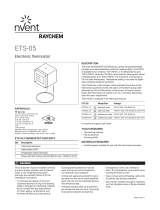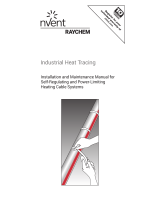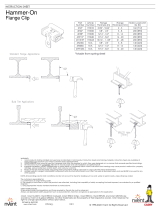
In-Pipe Freeze Protection Heating Cable Installation Instructions
In-Pipe Miser
WARNING:
DESCRIPTION
nVent RAYCHEM In-Pipe Miser is an energy efficient in-pipe heating cable
designed for freeze protection of insulated plastic potable water lines.
It is made with a tough mineral insulated heating cable for long life and
has a cord and plug for ease of installation. For use with either 1 inch or
1-1/4 inch plastic pipe.
The kit includes a ground-fault protected electronic temperature controller
to comply with nVent, NEC and CEC requirements for ground-fault
protection of equipment. It does not protect people against the hazards of
shock. Please leave these instructions with the homeowner.
Note: The blue tee fitting supplied with this heating cable is designed
for use with 1 inch or 1-1/4 inch ID polyethylene pipes and only for the
pipe types shown below.
I.D. Series 75 & 100 (PE 1404) (SIDR 9)
I.D. Series 125 (PE 2306, 2406 or 3406 resin) (SIDR 11.5)
I.D. Series 160 (PE 3408 resin) (SIDR 9)
TOOLS REQUIRED
ADDITIONAL MATERIALS REQUIRED
• Screwdriver
• Rubber mallet
• Pipe wrench to tighten nuts on
tee fitting
• Approximately 6 ft (2 m) of
strong string or cord
• Electrician’s fish tape
• A drill with appropriate bits for
opening hole in outside wall
to allow insulated pipe and
temperature sensor to pass
through
• (4) #8 mounting screws, for
temperature controller
• Duct tape to attach temperature
sensor and sensor lead wire to
pipe and to seal pipe insulation
• Closed cell foam pipe insulation
for your pipe size, minimum 1/2
in (13 mm) thick
• Wooden block
FIRE AND SHOCK HAZARD. In-Pipe Miser must be
installed correctly using the supplied temperature controller to
ensure proper operation and to prevent shock, fire or damage
to the pipe. Read these important warnings and carefully follow
all the installation instructions.
• In-Pipe Miser should not be used in uninsulated pipe. For
uninsulated pipes use nVent RAYCHEM In-Pipe Retro.
• The heating cable must be installed in accordance with
local and national electrical codes.
• Do not use a two-prong outlet, an extension cord, or with
any voltage other than 120 Vac.
• The ground-fault protected temperature controller must be
installed in a dry location. Press the test button, then reset
button, every month to assure proper operation.
• Do not unduly work or bend the cable (minimum inside
bend radius is 6 times the outside diameter of the heating
cable). Bend gently and avoid repeated sharp bends,
pinching, crimping, or flattening.
• Do not cut or alter the heating cable or power cord length.
• The heating cable must not pass through a pitless adaptor,
valve or shut off of any kind.
• Do not install this heating cable on the outside of piping.
• Do not energize the system until installation is complete
and the pipe is filled with water. Never energize the system
if the pipe is not filled with water.
• The temperature sensor must contact the pipe at all times
or it could sense an incorrect temperature.
KIT CONTENTS
Item Qty Description
A 1 Ground-fault protected temperature controller with
25 ft (7.6 m) sensor lead wire
B 2 1-1/4 inch pipe adaptor parts
C 2 1 inch pipe adaptor parts
D 1 Nut for plastic tee fitting
E 1 Plug-in heating cable with plastic tee fitting
F 1 Installation instructions (English and French)
F
E
A
B
C
D
APPROVALS
-PS,X/D
Made in Canada
Note: This product
is suitable for use in
potable water.













